Chicago Tribune, February 18, 1877

I was unable to find any more explicit documents in the press, or in the Lincoln Park Commissioners Proceedings, that elaborated beyond this short paragraph from a longer article about the progress of the transformation of the new park grounds. (See the Ira Couch section, left, to read about his heirs financial difficulties after his death.)
The earliest photographs I have seen of the tomb were taken during winter months, when the surrounding foliage seemed sparce. These early photographs were made more than twenty years after the vault was allowed to remain in the park. By that time, Chicago's next generation of park visitors saw the tomb as a novelty and various explanations for this remaining cemetery artifact had begun.
Chicago Tribune, February 11, 1892

An October 7, 1900, Chicago Tribune article relays a Supreme Court decision I had not seen before or since this publication, and I found no such case in the Supreme Court filings during these years. This article also details for the first time in this paper, other visible remnants from the City Cemetery. (See Other Remnants Left Behind, in the menu, above, for more about the Peacock family lot.)
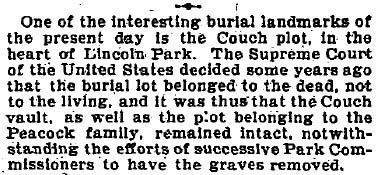
|
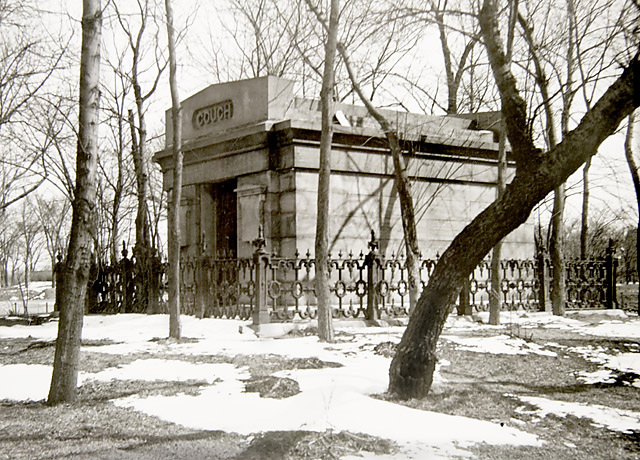
By permission and courtesy of the Chicago History Museum.
This view is likely from 1902. Except for the tree in the foreground, which is missing in the next picture, the other trunks look similar to those in the later photograph. A larger reproduction reveals the iron diamond-patterned gate covering the door to the tomb.
Scroll to the RIGHT ----->>
|
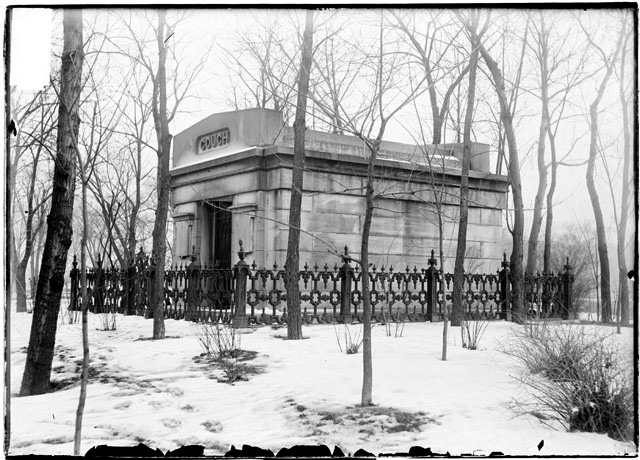
By permission and courtesy of the Chicago History Museum.
This photograph from 1903, was taken for the Chicago Daily News, as part of a group of pictures that thoroughly detailed the Lincoln Park grounds during a snow-covered, Chicago winter. (See other photographs from the Chicago Daily News archive here.) The older tree from the earlier photograph had been removed and new bushes had been planted around the site of the tomb. The masonry also appears to have been cleaned. Like today, the white tablets flanking the doorway are blank in both of these early photographs.
|

By permission and courtesy of the Chicago History Museum.
This 1911 photograph, shows the increasing density of the foliage around the tomb.
A January 12, 1912 Chicago Tribune article said,
"The Couch tomb is the sole visible relic of those graveyard days, the city having been unable for some reason to buy or dispossess the owners of this tomb and lot. Almost hidden in shrubbery, it stands as a silent reminder of that which cometh soon or late."
The figure standing near the tomb is a Lincoln Park police officer. At that time, the park had its own police force.
|
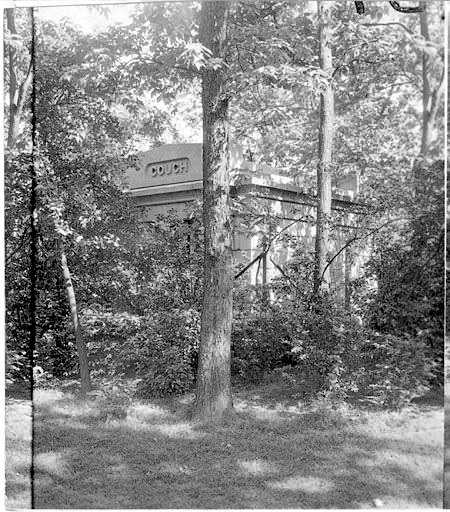
This 1929 photograph illustrates the commissioners success at hiding the Couch tomb. The original iron fencing had been replaced by a makeshift wire barrier.
This photograph, from the collection of the University of California, Riverside's, California Museum of Photography, is one half of a stereoview. That museum has more than one hundred fifty stereoviews of Lincoln Park, all taken during 1929. A stereoview is two side-by-side pictures, that when viewed with a special optical device shows a single image as a three-dimensional illusion. See the UCR museum's other photographs of Lincoln Park from 1929, here.
|
This untitled poem, by Adele Jordan Tarr, was
published on September 24, 1939 in the
Chicago Daily Tribune:
It stands aloof, neglected, with its guard
Of woven wire and posts . . . undignified,
As if to mock death’s majesty and pride.
Dry leaves and grasses heap the tiny yard;
The rusted gate, still served by rusted lock,
Intrigues a careless passerby or two.
They scan it idly. “Couch,” they read. “Now, who
Was he, to set his tomb within a park?”
They do not know this ground, where children play,
Was given by the dead who once slept there,
To serve the living for a playground, where
They throng in summer for a happy day.
O, sumacs! Cluster close against its gloom,
And shield with greenery this forgotten tomb. |
In the Chicago Park District’s special collections archive, there is a June 2, 1941, inter-office correspondence between the General Superintendent and the Assistant General Attorney:
“In answer to your request of May 26, 1941 relative to a case concerning the retention of the Couch Memorial Vault in Lincoln Park we wish to advise you that we have been unable to find a record of any such case in the published reports of the United States Supreme, Illinois Supreme or Illinois Appellate courts, in the indices of the Circuit and Superior Courts of Cook County between the years 1872 and 1905 or in the tract index in the Recorder’s Office.
Although the Act of 1869 creating the Commission of Lincoln Park specifically gave said commissioners authority to condemn the old cemetery it does not appear that this was done, nor does our index of deeds indicate that we ever secured title to the Couch plot in the old cemetery.
The Couch file in the “Morgue” of the Chicago Tribune contains a number of news items relating to the Couch family but does not indicate that at any time they were in litigation with the Lincoln Park Commissioners."
___________________________________________
In a January 3 1993 article in the Sunday Chicago Tribune magazine, Anne Keegan quoted a passage from a 1953 news article that I was unable to find:
“The massive couch family burial vault … is destined to be destroyed by time” “Time, with the help of vandals, is carrying out its order. The wire mesh fence surrounding the crypt is rusted, torn in spots and completely down in the rear. Many of the stone blocks are cracked, and others marred and chipped. The iron gate is rusted, and one of the bars gone, and the others misshapen and the lock missing… Two marble plaques, one on each side of the front, are scratched with writing, initials and drawings.”
|
I found more photographs of the Couch Tomb that illlustrate various states of neglect or conspicuous coverings over the years, but because of copyright restrictions after 1923, they are not represented on this Web Site.
In a May 6, 1951 photograph, reproduced for a Chicago Tribune article titled, "Forgotten Man Sleeps in Couch Resting Place," the same, or very similar fencing from 1929 appears to surround the tomb. Although the foliage appears more sparce, the site does not seem to be regarded with any real intent.
The next pictures, in the Chicago Tribune, on August 2, 1960, show the site in shambles. The article, by George Shreiber, titled, "Lincoln Park Tomb is Given Spruce-Up Job. Litter at Couch Tomb is Removed," was written when it was discovered that vandals had littered the area with broken glass and other debris. Contradicting the image from 1951, Schreiber says the fence was erected fifteen years prior "for the vault's protection." He further states that at the time the fence was installed, writing was sandblasted off its walls and the tomb was cleaned. The article also mentions that mortar is missing and the structure is in need of tuckpointing.
A 1969 view in the Tribune shows no foliage. A chain link fence surrounds the structure.
A 1977 picture in the same newspaper shows bushes surrounding the tomb again, and the front of the fence appears pulled down. This photograph clearly shows the door covered with plywood.
In a September 27, 1982 letter in the Chicago Sun-Times, a reader inquiring about the tomb, wrote, "It's a shame that weeds and trash have almost completely covered the monument. For this reason, we felt we had uncovered some hidden secret."
|
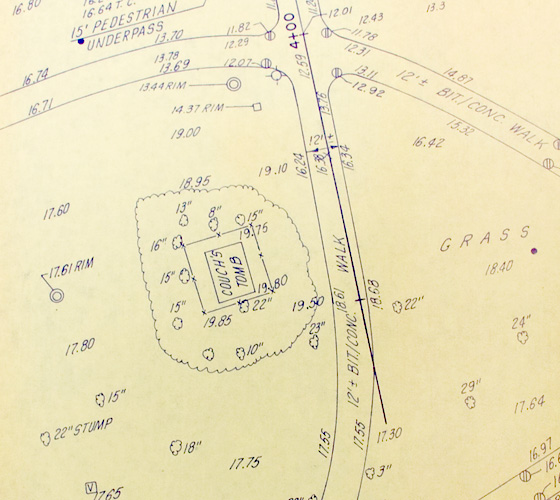
By permission and courtesy of the Chicago Park District Special Collections.
This detail of a map of the park grounds from a landscape survey in 1975, clearly shows the foliage shrouding the Couch Tomb. Each cloud-shaped form represents a tree with its diameter noted in inches. The massive cloud shape around the tomb illustrates the dense overgrowth.
|
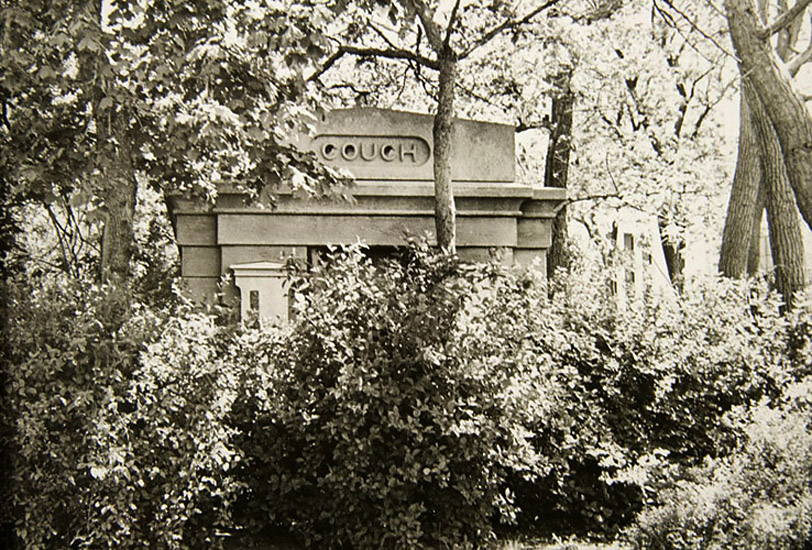
By permission and courtesy of the Chicago Park District Special Collections.
These last four photographs, from the Chicago Park District's archive, show an almost absurd progression of greenery overtaking the vault.
The pictures appear chronologically and are likely from the mid-1980s.
In 1994, an expensive renovation restored the site to a vision of its former self, now a grand monument to a forgotten early Chicagoan.
(See The Renovation section, left, for that story.)
|
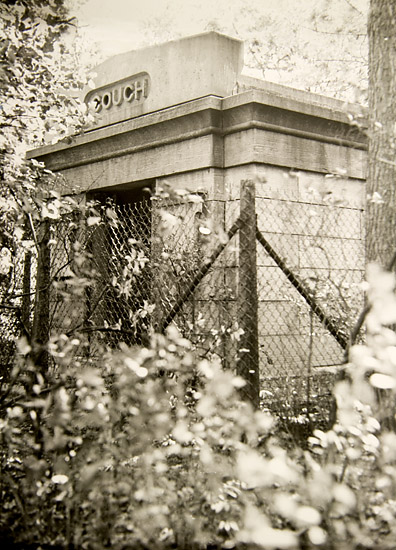
By permission and courtesy of the Chicago Park District Special Collections.
|
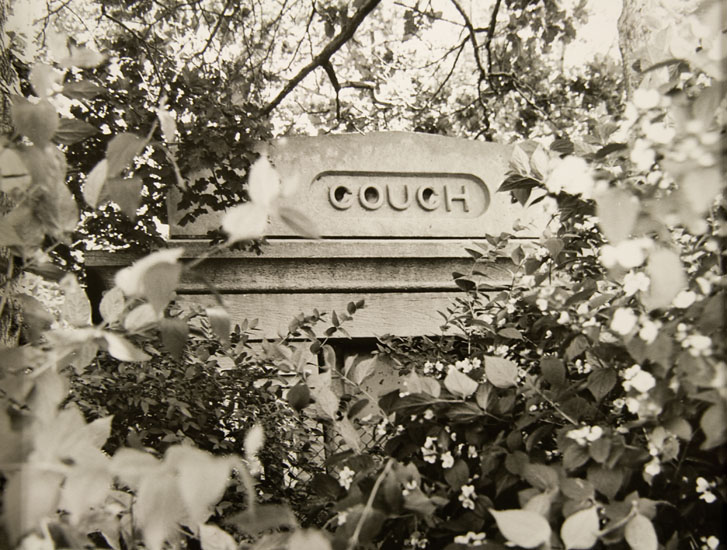
By permission and courtesy of the Chicago Park District Special Collections.
|
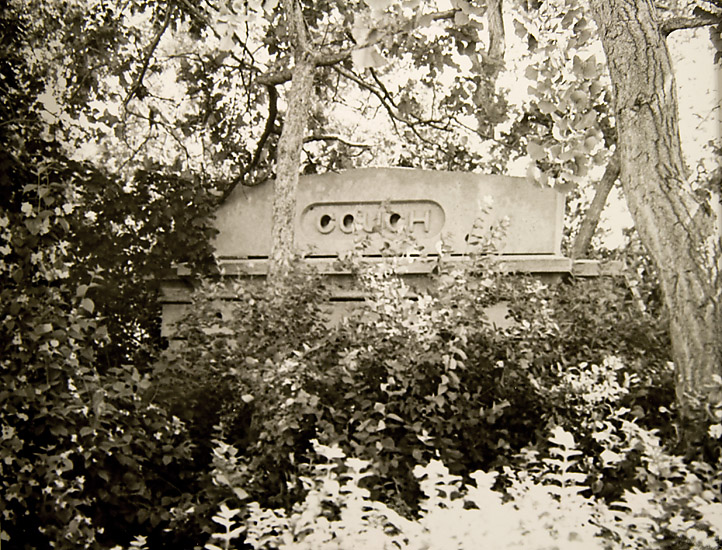
By permission and courtesy of the Chicago Park District Special Collections.
During the time these last four photographs were made showing the forest of foliage
surrounding the Couch Tomb, the site was known to be a gay male cruising area.
With a nod to those in the know, there was a gay nightclub called The Bushes, located at
3320 N. Halsted Street in Chicago's north side.
|